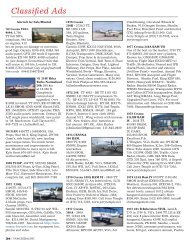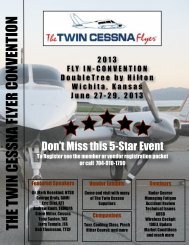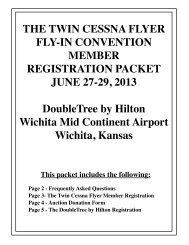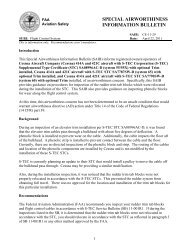Adjusting Fuel Flow - Twin Cessna Flyer
Adjusting Fuel Flow - Twin Cessna Flyer
Adjusting Fuel Flow - Twin Cessna Flyer
- No tags were found...
Create successful ePaper yourself
Turn your PDF publications into a flip-book with our unique Google optimized e-Paper software.
Any fuel system that cannot be adjusted to meetthe specified values will require repair orreplacement of the affected components prior tofurther engine operation.The adjustment procedures provided in this SIDalso apply to engine fuel systems equipped withTCM Position Tuned <strong>Fuel</strong> Nozzles. Refer to FormX306474, Position Tuned <strong>Fuel</strong> Nozzle Installationand Maintenance Manual for more detailedinformation and installation instructions.CAUTION...Refer to the torque specifications, Table 1, page 10for specified values when torquing hose endfittings.A. ADJUSTMENT TOOLS AND EQUIPMENTREQUIREDA complete set of tools and test equipment isessential for correct setup of TCM fuel injectionsystems. Various combinations of these tools andequipment will be used, depending on the enginemodel. A proper inventory of tools and equipmentfor fuel system adjustment will include thefollowing:1. TCM recommends the Model 20 ATM-C PortaTest Unit P/N 630045-20 ATM-C orequivalent to insure the fuel injection systemmeets all pressure and flow specifications. Youmay acquire a Model 20 ATM-C Porta TestUnit by contacting the following company:AERO TEST, Inc.29300 Goddard RoadRomulus, Michigan 48174(734) 946-7777An alternative procedure would be to usecalibrated gauges.1. One (1) calibrated 0-60 PSI gauge, graduatedin 1 PSI increments. This gauge will be usedfor unmetered pressure measurement.2. One (1) calibrated 0-30 PSI gauge, graduatedin .2 PSI (maximum) increments. This gaugewill be used for metered pressuremeasurements and verification of aircraft fuelflow gauge indications on normally aspiratedengines only.3. One (1) calibrated differential gauge, 0-30PSID maximum, graduated in .2 PSI(maximum) increments. This gauge will beused for metered pressure measurements andverification of aircraft fuel flow gauge onturbocharged engines only.NOTE…Pressure gauges must be accurate within ±1 %.Pressure gauges must be checked for accuracyand, if necessary, calibrated at least once eachcalendar year. Calibrated pressure gauges maybe purchased from various suppliers such as:Davis Instruments4701 Mount Hope DriveBaltimore, MD 21215Phone: 410-358-3900 or1-800-368-25164. Two (2) P/N MS51523-B4 swivel tee. Thesefittings will be used to tee into fuel lines forunmetered and metered pressure reference.5. Hoses of appropriate diameters and sufficientlengths to allow personnel and equipment to belocated away from propeller arc and blast area.6. Common hand tools including: 7/8”, 11/16”,9/16”, 1/2”, 3/8”, 7/16”, 11/32”, and 5/16”wrenches. A 1/4” drive ratchet and sockets,universal swivel, extension, and a 5/32” allenwrench common screw driver, a calibratedtorque wrench, an oil can, mirror andflashlight. Safety equipment including hearingand eye protection must be used.7. Tachometer verification instrument - varioustypes are available. Verify aircraft tachometeraccuracy prior to fuel system adjustment.B. PRE-SETUP PROCEDURES1. During engine installation, or if any fuelsystem component has been replaced, flush theaircraft fuel system by first removing theengine-driven fuel pump inlet hose andterminating the end into a large, cleancontainer. Operate the aircraft boost pump andallow a minimum of one gallon of fuel to flowthrough the system. Take necessaryprecautions to prevent a fire hazard. IfISSUED REVISED PAGE NO REVISIONMO DAY YEAR MO DAY YEARTM2 of 4003 24 97 02 25 2005 Teledyne Continental Motors, Inc. SID97-3 CA Teledyne Technologies CompanyP.O. Box 90 Mobile Alabama • 251-438-3411
















